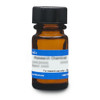Spinosad is a mixture of Spinosyn A and Spinosyn D. Spinosyns (macrocyclic lactones/macrolide insecticides) are extracted from the fermentation broth of Saccharopolyspora spinosa. This bacterial strain was isolated from a soil sample collected at a defunct sugar mill rum still in the Virgin Islands (Mertz and Yao, 1990). Spinosin A is produced in the greatest quantity, followed by Spinosyn D which differs from Spinosyn A by having a methyl group instead of a hydrogen atom at position C6 on the macrolide. The other 21 spinosyns are produced in very small quantities. Spinosad is used as a bio-insecticide as it shows efficacy against a variety of insects. Spinosyn A and D have the highest level of insecticidal activity. The Spinosyns do not have antibiotic effects on bacteria or fungi.
The spinosyns are soluble in organic solvents.
| Application | Used as an analytical standard. Can also be used as a chromatographic and environmental standard. |
| Mechanism of Action | The compound is active by contact or ingestion, and its effect depends on the insect species and life stage. Spinosad affects the insect nervous system, acting as agonists of insect nicotinic acetylcholinesterase receptors (nAChRs) which leads to disruption of acetylcholine neurotransmission. It has secondary effects as a gamma-amino-butyric acid (GABA) neurotransmitter agonist that stimulates the nervous system. |
| Microbiology Applications | The search for semisynthetic derivatives has already produced over 1000 Spinosyn analogs and derivatives. Mutant strains can be used to study biosynthetic pathways. Biosynthesis and genetic engineering can be used to discover novel applications (Kirst, 2010). |
| Plant Biology Applications | Spinosad is a natural product approved for use in organic agriculture as an insecticide and crop protectant. It is effective against Lepidoptera and Diptera along with several other insects including planthoppers, leafhoppers, spider mites and cockroaches. It has an excellent environmental and mammalian toxicological profile. It is fast acting, and insects exposed to the compound show lack of coordinated movement and stop feeding within minutes. Mortality can occur 1-24 hours after exposure. In the field, control is observed within 1-2 days of treatment, but in lab bioassays, mortality may continue up to 3 days. (ref: book chapter) |
| Insect Biology Applications | Genome editing using the CRISPR/Cas9 system has only been achieved in a handful of insect species. Researchers used the CRISPR/Cas9 gene editing platform to introduce the G275E mutation into the nAChR α6 subunit of Drosophila melanogaster. A 66-fold decrease in sensitivity to Spinosad was observed in flies with the mutation compared to flies of the same genetic background minus the mutation, demonstrating the functional role of this amino acid substitution to Spinosad resistance. The LC50 increased from 5 mg/L to 335 mg/L. G275E is inherited as an incompletely recessive trait. This study shows how recent advances in genome editing can be harnessed to study insecticide resistance. (Zimmer et al, 2016). |
| Molecular Formula | C83H132N2O20 |
| Solubility | Slightly soluble in methanol, acetone, DMSO or chloroform. Insoluble in water. |
| References | Kirst HA (2010) The spinosyn family of insecticides: Realizing the potential of natural products research. J. Antibiotics 63:101-111 Lopez O and Fernandez-Bolanos JG ed. (2011) The Spinosyn insecticides. In: Green trends in insect control. RSC Green Chemistry Series No. 11, RSC Publishing, Ch. 5: pp 163-212 Mertz F and Yao RC (1990 Saccaropolyspora spinosa sp. nov. isolated from soil collected in a sugar mill rum still. Int. J. Sys. Bacteriol. 40(1):34-39 Zimmer CT et al (2016) A CRISPR/Cas9 mediated point mutation in the alpha 6 subunit of the nicotinic acetylcholine receptor confers resistance to Spinosad in Drosophila melanogaster. Insect Biochem. Molec. Biol. 73:62-69 PMID 27117524 |


